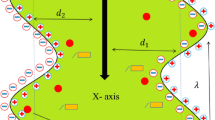Abstract
The electro-osmotic flow of an aqueous solution of NaCl between two parallel silicon walls is studied through a molecular dynamics simulation. The objective here is to examine the dependency of the electro-osmotic flow on the surface charge density by considering the changes made in the structural properties of the electric double layer (EDL). The ion concentration, velocity profiles, and electric charge density of the electrolyte solution are investigated. Due to the partially charged atoms of the water molecules, water concentration is of a layered type near the wall. The obtained profiles revealed that an increase in the surface charge density, at low surface charges where the governing electrostatic coupling regime is Debye–Hückel, increases both the electro-osmotic velocity and the EDL thickness; whereas, a decreasing trend is observed in these two parameters in the intermediate regime. For high values of surface charge density, due to the charge inversion phenomenon, the reversed electro-osmotic flow will be generated in the channel. Results indicate that the absolute value of the reversed electro-osmotic velocity rises with an increase in the surface charge density.















Similar content being viewed by others
References
Freund JB (2001) Electro-osmosis in a nanometer-scale channel studied by atomistic simulation. J Chem Phys 116:2194–2200
Dongqing L (2004) Chapter 4 Electroosmotic flows in microchannels. Interface Sci Technol pp 92–203
Helmholtz H (1879) Studien über electrische Grenzschichten. Ann Phys 243:337–382
Yang C, Li D (1997) Electrokinetic effects on pressure-driven liquid flows in rectangular microchannels. J Colloid Interface Sci 194:95–107
Bianchi F, Ferrigno R, Girault HH (2000) Finite element simulation of an electroosmotic-driven flow division at a T-junction of microscale dimensions. Anal Chem 72:1987–1993
Gao Y, Wong TN, Chai JC, Yang C, Ooi KT (2005) Numerical simulation of two-fluid electroosmotic flow in microchannels. Int J Heat Mass Transf 48:5103–5111
Patankar NA, Hu HH (1998) Numerical simulation of electroosmotic flow. Anal Chem 70:1870–1881
Arnold AK, Nithiarasu P, Tucker PG (2008) Finite element modeling of electro-osmotic flows on unstructured meshes. Int J Numer Meth Heat Fluid Flow 18:67–82
Qiao R, Aluru NR (2005) Atomistic simulation of KCl transport in charged silicon nanochannels: interfacial effects. Colloids Surf, A 267:103–109
Qiao R., Aluru N. R. (2004) Charge inversion and flow reversal in a nanochannel electro-osmotic flow. Phys Rev Lett 92
Chen Y, Ni Z, Wang G, Xu D, Li D (2007) Electroosmotic flow in nanotubes with high surface charge densities. Nano Lett 8:42–48
Jelinek B, Felicelli SD, Mlakar PF, Peters JF (2009) Molecular dynamics study of temperature effects on electrokinetic transport in si nanochannel. In: ASME 2009 International mechanical engineering congress and exposition Lake Buena Vista, Florida, USA
Toghraie Semiromi D, Azimian AR (2010) Nanoscale Poiseuille flow and effects of modified Lennard-Jones potential function. Heat Mass Transf 46:791–801
Toghraie Semiromi D, Azimian AR (2010) Molecular dynamics simulation of liquid–vapor phase equilibrium by using the modified Lennard-Jones potential function. Heat Mass Transfer 46:287–294
Toghraie Semiromi D, Azimian AR (2011) Molecular dynamics simulation of nonodroplets with the modified Lennard-Jones potential function. Heat Mass Transf 47:579–588
Toghraie Semiromi D, Azimian AR (2012) Molecular dynamics simulation of annular flow boiling with the modified Lennard-Jones potential function. Heat Mass Transf 48:141–152
Andelman D (1995) Electrostatic properties of membranes: the Poisson-Boltzmann theory. Handbook Biol Phys 1:603–642
Berendsen HJC, Postma JPM, van Gunsteren WF, Hermans J (1981) Interaction models for water in relation to protein hydration. intermolecular forces: 331–342
Hess B, Kutzner C, van der Spoel D, Lindahl E (2008) GROMACS 4: algorithms for highly efficient, load-balanced, and scalable molecular simulation. J Chem Theory Comput 4:435–447
Hockney RW, Eastwood JW (1981) Computer simulation using particles. New York
Barrat JL, Bocquet L (1999) Large slip effect at a nonwetting fluid-solid interface. Phys Rev Lett 82:4671–4674
Straeter TA (1971) On the extension of the davidon-broyden class of rank one, quasi-newton minimization methods to an infinite dimensional hilbert space with applications to optimal control problems. North Carolina State Univ, Raleigh
Plimpton S (1995) Fast parallel algorithms for short-range molecular dynamics. J Comput Phys 117:1–19
Bazart M (2005) Personal communications. Department of Mechanical Engineering, MIT
Wang M, Liu J, Chen S (2007) Electric potential distribution in nanoscale electroosmosis: from molecules to continuum. Taylor & Francis, London
Poppe H, Cifuentes A, Kok WT (1996) Theoretical description of the influence of external radial fields on the electroosmotic flow in capillary electrophoresis. Anal Chem 68:888–893
Acknowledgments
The computational support by the National High Performance Computing Center of Sheikh-Bahaei at the Isfahan University of Technology, Iran, is appreciated.
Author information
Authors and Affiliations
Corresponding author
Rights and permissions
About this article
Cite this article
Rezaei, M., Azimian, A.R. & Semiromi, D.T. The surface charge density effect on the electro-osmotic flow in a nanochannel: a molecular dynamics study. Heat Mass Transfer 51, 661–670 (2015). https://doi.org/10.1007/s00231-014-1441-y
Received:
Accepted:
Published:
Issue Date:
DOI: https://doi.org/10.1007/s00231-014-1441-y




